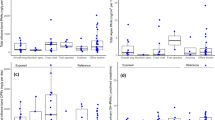Summary
The exposure to organic solvents among 12 graffiti removers was studied. Health effects were also assessed by structured interview and a symptom questionnaire. Blood and urine samples were collected at the end of the day of air sampling. The concentrations of dichloromethane, glycol ethers, trimethylbenzenes and N-methyl-2-pyrrolidinone in the breathing zone of each worker were measured during one working day. The 8-h time-weighted average exposure to dichloromethane ranged from 18 to 1200 mg/m3. The Swedish Permissible Exposure Limit value for dichloromethane is 120 mg/m3. The air concentrations of glycol ethers, trimethylbenzens and N-methyl-2-pyrrolidinone were low or not detectable. No exposure-related deviations in the serum concentrations of creatinine, aspartate transaminase, alanine transaminase, γ-glutamyl transpeptidase or hyaluronan or the urine concentrations of α1-microglobulin, R2-microglobulin or N-acetyl-β-glucos-aminidase were found. Irritative symptoms of the eyes and upper respiratory tract were more prevalent than in the general population. This study demonstrates that old knowledge about work harzards is not automatically transferred to new professions. Another aspect is that the public is also exposed as the job is performed during daytime in underground stations. At least for short periods, bystanders may be exposed to high concentrations of organic solvent vapours. People with predisposing conditions, e.g. asthmatics, may risk adverse reactions.
Similar content being viewed by others
References
Akhter SA, Barry BW (1985) Absorption through human skin of ibuprofen and flurbiprofen; effect of dose variation, deposited drug films, occlusion and the penetration enhancer N-methyl-2-pyrrolidone. J Pharm Pharmacol 37:27–37
Barry BW, Southwell D, Woodford R (1984) Optimization of bioavailability of topical steroids: penetration enhancers under occlusion. J Invest Dermatol 82:49–52
Carpenter CP, Weil CS, Smyth HF Jr (1974) Range-finding toxicity data: list VIII. Toxicol Appl Pharmacol 28:313–319
IARC (1991) Some organic solvents, resins, monomers and related compounds, pigments and occupational exposure in paint manufacture and painting. IARC Monographs on the Evaluation of Carcinogenic Risk to Humans 47, IARC, Lyon
Kubic VL, Anders MW, Engel RR, Barlow CH, Canghey WS (1974) Metabolism of dihalomethanes to carbon monoxide. In vivo studies. Drug Metab Dispos 2:53–57
Morris JB, Smith F, German R (1979) Studies on methylene cloride-induced fatty liver. Exp Mol Pathol 30:386–393
Moskowitz S, Sharpio H (1952) Fatal exposure to methylene chloride vapor. Arch Ind Hyg Occup Med 6:116–123
National Board of Occupational Safety and Health. Code of Statutes (1990) AFS 1990: 13. Stockholm
Norbäck D, Edling C (1991) Environmental, occupational, and personal factors related to the prevalence of sick building syndrome in the general population. Br J Ind Med 48:451–462
Ruth JH (1986) Odor thresholds and irritation levels of several chemical substances: a review. Am Ind Hyg Assoc J 3:A142-A151
Sahu SC, Lowther DK (1981) Pulmonary reactions to inhalation of methylene chloride, effects on lipid peroxidation in rats. Toxicol Lett 8:253–256
Soden KJ (1993) An evaluation of chronic methylene chloride exposure. J Occup Med 35:282–286
Smyth HF Jr, Carpenter CP, Weil CS, Pozzani VC, Striegel JA, Nycum JS (1969) Range-finding toxicity data: list VII. Am Ind Hyg Assoc J 30:470–476
Starman K, Moferson H, Caraceio T (1985) Methylene chloride inhalation: an unusual form of drug abuse. Ann Emerg Med 14:903–905
Stewart RD, Foster HV, Huke CL, Lebrun AJ, Peterson JE (1973) Human responses to controlled exposures to methylene chloride vapor. Report No NIOSH-MCOW-ENUMMC-73-7. The Medical College of Wisconsin, Milwaukee, Wis.
Threshold Limit Values and Biological Exposure Indices for 1988–1989 (1988) American Conference of Govememental Industrial Hygienists, Inc., Cincinnati, Ohio
Wells CG, Waldron HA (1984) Methylene chloride burns. Br J Ind Med 41:420
WHO/Nordic Council of Ministers (1985) Organic solvents and the central nervous system. Environmental Health 5. WHO Regional Office for Europe, Copenhagen
Winck CL, Collom WD, Esposito F (1981) Accidental methylene chloride fatality. Forensic Sci Int 18:165–168
Author information
Authors and Affiliations
Rights and permissions
About this article
Cite this article
Anundi, H., Lind, ML., Friis, L. et al. High exposures to organic solvents among graffiti removers. Int. Arch Occup Environ Heath 65, 247–251 (1993). https://doi.org/10.1007/BF00381198
Received:
Accepted:
Issue Date:
DOI: https://doi.org/10.1007/BF00381198



